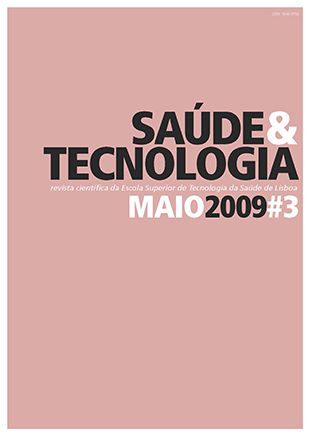Avaliação de dois métodos laboratoriais para diagnóstico de hidatidose
DOI:
https://doi.org/10.25758/set.204Palavras-chave:
Echinococcus granulosus, Hidatidose, ELISA, FEIAResumo
A hidatidose, vulgarmente conhecida por quisto hidático, é causada pelos estados larvares do parasita Echinococcus granulosus. O seu diagnóstico baseia-se na clínica, na epidemiologia e nas técnicas imagiológicas, sendo suportado por testes serológicos. O tratamento mais comum é o cirúrgico, sendo importante o diagnóstico definitivo da doença antes da cirurgia, para se prevenir a disseminação dos quistos que pode ocorrer durante a mesma. Neste trabalho comparam-se dois métodos imunoserológicos para o
diagnóstico da hidatidose: Enzyme-linked Immunosorbent Assay (ELISA) para pesquisa de Imunoglobulina G; e Fluoro-enzyme Immunoassay (FEIA) para pesquisa de Imunoglobulina E. Dos 55 indivíduos incluídos no estudo, todos em fase pré-operatória, 31% possuíam quisto hidático calcificado, 54,5% quisto hidático não calcificado e 14,5% não possuíam hidatidose, mas quistos simples. Os testes apresentaram a mesma especificidade (87,5%), sendo a sensibilidade do ELISA IgG mais baixa (63,8%) do que a do FEIA IgE (76,6%). Foi demonstrada uma boa correlação entre os dois métodos (r = 0,726, p < 0,05).
Downloads
Referências
David-Morais JA. Estudo epidemiológico da equinococosehidatidose no distrito de Évora: problemática metodológica. Rev Port Doenç Infec. 1997;20(3):137-45. Portuguese
David-Morais JA. A hidatidologia em Portugal. Lisboa: Fundação Calouste Gulbenkian; 1998. ISBN 9723108119
David-Morais JA. Hidatidose humana: estudo clínico-epidemiológico no distrito de Évora durante um quarto de século [Human hydatidosis in the district of Évora, Portugal: a clinical-epidemiological study over a quarter of a century]. Acta Med Port. 2007;20:1-10. Portuguese
Rey L. Bases da parasitologia médica. 2ª ed. Rio de Janeiro: Guanabara Koogan; 2002. ISBN 8527706938
Biava MF, Dao A, Fortier B. Laboratory diagnosis of cystic hydatic disease. World J Surg. 2001 Jan;25(1):10-4.
Ortona E, Vaccari S, Marqutti P, Delunardo F, Rigano R, Profumo E, et al. Immunological characterization of Echinococcus granulosus cyclophilin, an allergen reactive with IgE and IgG4 from patients with cystic echinococcosis. Clin Exp Immunol. 2002 Apr;128(1):124-30.
Zhang W, Li J, McManus DP. Concepts in immunology and diagnosis of hydatic disease. Clin Microbiol Rev. 2003 Jan;16(1):18-36.
Carmena D, Martínez J, Benito A, Guisantes JA. Shared and non-shared antigens from three different extracts of the metacestode of Echinococcus granulosus. Mem Inst Oswaldo Cruz. 2005 Dec;100(8):861-7.
Afferni C, Pini C, Misiti-Dorello P, Bernardini L, Conchedda M, Vicari G. Detection of specific IgE antibodies in sera from patients with hydatidosis. Clin Exp Immunol. 1984 Mar;55(3):587-92.
Sbihi Y, Rmiqui A, Rodriguez-Cabezas MN, Orduña A, Rodriguez-Torres A, Osuna A. Comparative sensitivity of six serological tests and diagnostic value of ELISA using purified antigen in hydatidosis. J Clin Lab Anal. 2001;15(1):14-8.
Downloads
Publicado
Edição
Secção
Licença
Direitos de Autor (c) 2023 Saúde & Tecnologia

Este trabalho encontra-se publicado com a Licença Internacional Creative Commons Atribuição-NãoComercial-SemDerivações 4.0.
A revista Saúde & Tecnologia oferece acesso livre imediato ao seu conteúdo, seguindo o princípio de que disponibilizar gratuitamente o conhecimento científico ao público proporciona maior democratização mundial do conhecimento.
A revista Saúde & Tecnologia não cobra, aos autores, taxas referentes à submissão nem ao processamento de artigos (APC).
Todos os conteúdos estão licenciados de acordo com uma licença Creative Commons CC-BY-NC-ND. Os autores têm direito a: reproduzir o seu trabalho em suporte físico ou digital para uso pessoal, profissional ou para ensino, mas não para uso comercial (incluindo venda do direito a aceder ao artigo); depositar no seu sítio da internet, da sua instituição ou num repositório uma cópia exata em formato eletrónico do artigo publicado pela Saúde & Tecnologia, desde que seja feita referência à sua publicação na Saúde & Tecnologia e o seu conteúdo (incluindo símbolos que identifiquem a revista) não seja alterado; publicar em livro de que sejam autores ou editores o conteúdo total ou parcial do manuscrito, desde que seja feita referência à sua publicação na Saúde & Tecnologia.







